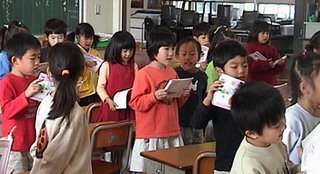SCHOOLING IN JAPAN

Education in Japanese society
Having just returned from an Art Class Trip to Japan, and having experienced a homestay visit at a school with no previous history of foreign exchange, I was interested to find out more about the Japanese Education System. Here's what Wiki had to say......Bibliographic details for "Education in Japan"
- Page name: Education in Japan
- Author: Wikipedia contributors
- Publisher: Wikipedia, The Free Encyclopedia.
- Date of last revision: 2 November 2006 11:48 UTC
- Date retrieved: 8 November 2006 10:11 UTC
- Permanent link: http://en.wikipedia.org/w/index.php?title=Education_in_Japan&oldid=85237368

Japanese tradition stresses respect for society and the established order and prizes group goals above individual interests. Schooling also emphasizes diligence, self-criticism, and well-organized study habits. More generally, the belief is ingrained that hard work and perseverance will yield success in life. Much of official school life is devoted directly or indirectly to teaching correct attitudes and moral values and to developing character, with the aim of creating a citizenry that is both literate and attuned to the basic values of culture and society.
At the same time, the academic achievement of Japanese students is high by international standards. Japanese children consistently rank at or near the top in successive international tests. The system is characterized by high enrollment and retention rates throughout. An entrance examination system, particularly important at the college level, exerts strong influences throughout the entire system. The structure does not consist exclusively of government-sponsored, formal official education institutions. Private education also forms an important part of the educational landscape, and the role of schools outside the official school system cannot be ignored, indeed private colleges, often with very little emphasis on academics, constitute the majority.
Most children begin their education by attending preschool, although it is not part of the official system. The official structure provides compulsory, free schooling and a sound and balanced education to virtually all children from grade one through grade nine. Upper-secondary school, from grades ten through twelve, although also not compulsory, attracts about 94 percent of those who complete lower-secondary school. About one-third of all Japanese upper-secondary school graduates advance to tertiary education—to full four-year universities, two-year junior colleges, or to other institutions.
All Japanese students participate in a cleaning rountine on a daily basis. Brooms, rakes and mops are standard equipment kept in neat order.Order is essential and students are drilled from an early age to keep their belonging in a tidy and coherent manner.
Students change shoes when they enter an indoor area, from outdoor shoes, to soft soled indoor shoes. This reflects the their Shinto tradition relating to a deep respect for the nature beings and elemental forces. Transitional traditions, such as changing shoes are of the upmost impotance.
Respect is a cornerstone of Japanese society.
Anyone for school lunch?..... usually provided free of charge from the school!






0 Comments:
Post a Comment
<< Home